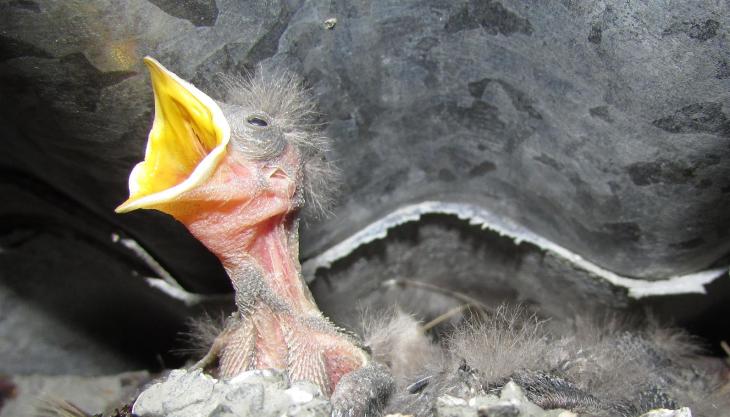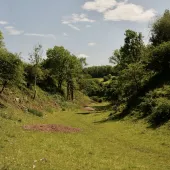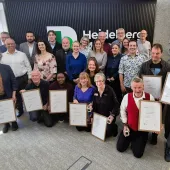MPA Quarries & Nature 2015

Event reveals how the mineral products industry is playing a key role in building on Britain’s Natural Capital
THE mineral products industry has long been delivering innovative and imaginative high-quality restoration and management of quarries, and is in a unique position to deliver more and contribute to the country’s stock of Natural Capital.
This was the message from the Mineral Products Association’s ‘Quarries & Nature 2015 – Building on Britain’s Natural Capital’ event, hosted by BBC ‘Countryfile’ presenter Helen Skelton, on Wednesday 14 October at The Royal Society, London, with more than 60 different environmental and conservation organizations in attendance.
Taking place on the same day that the Government launched its 25-year Environment Plan, the event celebrated the excellent work Mineral Products Association (MPA) member companies are undertaking by showcasing some of the best examples of quarry restoration and wildlife conservation anywhere in Europe, via the MPA Restoration Awards, the MPA Biodiversity Awards, in association with Natural England, and the inaugural MPA Nature Photo competition.
A Natural Capital accounting pilot study at Tarmac’s Mancetter Quarry, in Warwickshire, set the scene for a panel debate with distinguished experts Prof. Dieter Helm, former chairman of the Natural Capital Committee, Alan Law, chief strategy and reform officer with Natural England, and Tony Juniper, one of the best known names in environmental campaigning.
MPA chief executive Nigel Jackson said: ‘We are celebrating and showcasing some of the wonderful things our industry is doing for biodiversity and wider environmental, social and economic benefits. As well as delivering improvements in biodiversity and natural beauty for their own sake, we deliver other benefits and services such as public access, culture and recreation, water management, and carbon sequestration through working, management and restoration of land.
‘This event reaffirms that this is an industry that is uniquely placed to deliver not only biodiversity, but also wider benefits, contributing to the stock of ‘Natural Capital’.’
Natural England’s chief strategy and reform officer, Alan Law, said: ‘We are delighted to be working with the MPA again on this year’s Landscape-scale biodiversity award. The award always attracts fantastic examples of companies working in partnership with others to enhance and build the network of places supporting our wildlife.
‘This brings to life the vision to make places better for wildlife, making them bigger, creating more and joining them up. This is particularly impressive where there are clear win-wins for the businesses, wildlife and landscape, and the local communities. Biodiversity underpins the country’s Natural Capital and so the landscape-scale projects led by minerals companies are not only enhancing wildlife, but also building the local Natural Capital.’
Environmental campaigner and writer Tony Juniper said: ‘The conservation debate has moved on. It’s no longer only about protecting rare species and habitats from development and pollution, but is also now about restoring nature, and not only for its own sake but so that society can benefit from the many wonderful things the natural world does for us.
‘A number of industries have realized that they have a key role to play and are demonstrating how it is possible, through some thoughtful planning and modest investment of resources, to achieve really outstanding results. Mineral products companies in the MPA are among the real leaders.’
Live presentations were complemented by on-screen video footage of the winning sites. The MPA’s long-standing Restoration Awards, now in their 45th year, recognize exceptional practice. This year the coveted Cooper-Heyman Cup for outstanding achievement in restoration went to Hanson UK, in partnership with landowner Geoffrey Hemus, the RSPB, Aston Villa FC and the Middleton Hall Trust, for Middleton Hall Quarry, Warwickshire.
‘The project at the 470ha site has produced a mix of football pitches, reed beds, woodland, pasture and fishing. Hanson worked closely with the Environment Agency on experimental extraction of gravel from the river bank, which created islands, gravel bars and other features to enhance the habitat value and help alleviate flooding in the wider area.
CEMEX UK and Gallagher Aggregates were highly commended for Powburn Quarry, in Northumberland, and Workhouse Quarry, near Maidstone, Kent, respectively.
At Powburn, in partnership with landowner John Carr Ellison, CEMEX have created a place that is loved by both wildlife and the community, not least the local primary school which has its own direct access. The site has two lakes, one for fishermen as well as nature conservation. Facilities include a bird hide, interpretation boards, a dipping pond and disabled access.
At Workhouse Quarry, Gallaghers did not work the aggregates but did handle the filling and restoration, and their sister company now farms the land. The site was filled with inert construction waste that could not be recycled. Today, the completed landform includes a wildlife corridor with hedgerows linking two older woodlands, as well as a drainage pond that provides another valuable habitat.
The third MPA Biodiversity Awards once again attracted an excellent range of entries from both large and small companies, providing a showcase of the diverse projects that minerals companies are undertaking to help nature. Entries were made under the award categories of Landscape-scale, Innovation, Planned, and Individual Contribution, although many entries demonstrated all of these qualities, so it proved difficult to consider them strictly within these bounds.
The overall winners of the Natural England Award for Landscape-scale were Batts Combe and Callow Rock in Somerset, a joint entry from Hanson and Aggregates Industries. The companies’ landholdings in the area together cover around 450ha and work has been under way for the last 20 years.
The judges were particularly impressed by the joint collaboration with Somerset Wildlife Trust and Natural England to target conservation work to ensure maximum benefits were delivered in creating and managing calcareous grassland, woodland and hedgerow habitats to expand and join them up with the surrounding area.
Winners of the Innovation category were two projects being undertaken by CEMEX to assist in the conservation of two rare bird species – the twite and the turtle dove. The judges were particularly impressed by the joint working with the RSPB and the innovative and imaginative approach to providing habitats in Derbyshire (twite) and Warwickshire (turtle dove).
CEMEX are managing hay meadows and creating conditions on their sites to allow pioneer plant species more usually associated with arable land to flourish and provide seeds for the birds to feed at critical times of the year. Although still early days, results indicate that the local twite population is already benefitting. The turtle dove project is part of an international initiative by CEMEX with Birdlife partners in France and Spain.
The winner of the Planned category was Smiths & Sons (Bletchington) for their extension to Gill Mill Quarry in West Oxfordshire. The restoration plan includes creation of 120ha of priority habitats, including one of the largest reed beds (60ha) in southern England. It will also include extensive new public access and a number of eco-lodges to benefit the local economy and provide revenue for sustainable management of the resulting nature reserve.
The judges were particularly impressed by the scale and ambition of the project, and the fact that the design reflects the views of conservation bodies, the local community, the local authority and the Ministry of Defence. The site lies under the flight path of RAF Brize Norton and the extensive reed bed will help to reduce the risk of birdstrike for aircraft while providing habitat for rare species, including the bittern, water vole and otter.
The scheme also reflects the need to conserve existing habitats of biodiversity and cultural value, and makes a landscape-scale contribution to the wider Windrush Valley, while also helping flood management.
The winner of the award for Individual Contribution was Chris Pennock of Tarmac for his work at Nosterfield Quarry, in North Yorkshire. Over the years, Mr Pennock has been instrumental in the management of the site, growing the number of visitors and educating people about the quarry and its wildlife.
His personal interest and research into the black poplar has resulted in him developing partnerships with the local council and conservation groups and propagating trees for planting in the quarry, to help conserve this rare species. His story shows how working in the industry can have positive impacts on the personal development of employees, as well as on wildlife and the community.
MPA Special Awards were presented to the following for their outstanding contributions:
- Tarmac for their pioneering work on Natural Capital at Mancetter Quarry
- Anthony Allday, assistant quarry manager at Aggregates Industries’ Greystone Quarry, Cornwall, for personal dedication to bee-keeping.
- Hills Group, Hanson UK, Cullimore Group, Aggregate Industries and Tarmac for their contribution to the restoration of The Cotswold Water Park, Gloucestershire – an area larger than the Norfolk Broads which collectively forms a major asset for wildlife conservation and recreation.
The MPA’s first Nature Photo Competition attracted some stunning entries from company employees and from RSPB and Wildlife Trust volunteers. Winner of the Employee category was Michael Cardus from Tarmac’s Dry Rigg Quarry, Horton-in-Ribblesdale, North Yorkshire, for his ‘Swallows nesting in a power shed at the quarry’ (pictured).
Second prize went to Paul McBurnie from Aggregate Industries’ Glensanda Quarry, in Scotland, for his photo of a stag deer, and third prize went to Linda Thompson of Irish Salt Mining & Exploration Co. Ltd’s Kilroot Mine, near Carrickfergus, Co. Antrim, for her shot of a fully weaned grey seal pup.
Winner of the Volunteer category was John Kaczanow, Wildlife Trust and BTO volunteer, for his image ‘Juvenile Peregrine Falcon – The last to fledge’. The judging was guided by wildlife educationalist Kate Macrae, BBC ‘Farming Today’ presenter and writer Sybil Ruscoe, and wildlife photographer Russell Savory.
For full details of this year’s winners, visit the Quarries and Nature web zone at: www.mineralproducts.org








